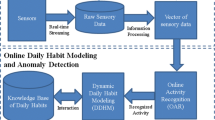Abstract
One of the most challenging issues faced by many elders is the over-decreasing independence mainly caused by impaired physical, cognitive, and/or sensory abilities. Activity recognition can be used to help elders live longer in their own homes independently, by providing assurance of safety, instructing performance of activity and assessing cognitive status. In this work, we propose to discover both intra- and inter-activity association patterns from daily routines of elderly people. Specifically, a data mining method is proposed to extract the most frequent sequential sequences of steps inside each individual activity (i.e., intra-activity pattern) and activities (i.e., inter-activity pattern) of a set of daily activities. These patterns can then be used to model human daily activities for activity recognition purpose, or to directly instruct/prompt elders with impaired memory when they perform daily routines. The experimental results conducted on two individuals’ datasets of daily activities show that our proposed approach is workable to discover these association patterns.
Access this chapter
Tax calculation will be finalised at checkout
Purchases are for personal use only
Preview
Unable to display preview. Download preview PDF.
Similar content being viewed by others
References
Pollack, M.E.: Intelligent Technology for an Aging Population: The Use of AI to Assist Elders with Cognitive Impairment. AI Magazine 26(2), 9–24 (2005)
Bao, L., Intille, S.S.: Activity Recognition from User-Annotated Acceleration Data. In: Ferscha, A., Mattern, F. (eds.) PERVASIVE 2004. LNCS, vol. 3001, pp. 1–17. Springer, Heidelberg (2004)
Huỳnh, T., Blanke, U., Schiele, B.: Scalable recognition of daily activities with wearable sensors. In: Hightower, J., Schiele, B., Strang, T. (eds.) LoCA 2007. LNCS, vol. 4718, pp. 50–67. Springer, Heidelberg (2007)
Patternson, D.J., Fox, D., Kautz, H., Philipose, M.: Fine-grained Activity Recognition by Aggregating Abstract Object Usage. In: Proc. of IEEE International Symp. Wearable Computers (2005)
Philipose, M., Fishkin, K.P., Perkowitz, D., Patterson, D.J., Fox, D., Kautz, H., Hahnel, D.: Inferring Activities from Interactions with Objects. IEEE Pervasive Computing 3(4), 50–57 (2004)
Chikhaoui, B., Wang, S., Pigot, H.: A frequent pattern mining approach for ADLs recognition in smart environments. In: Proc. of the 25th International Conference on Advanced Information Networking and Applications (AINA), pp. 248–255 (2011)
Lymberopoulos, D., Bamis, A., Savvides, A.: Extracting Spatiotemporal Human Activity Patterns in Assisted Living using a Home Sensor Network. Universal Access in the Information Society 10(2), 125–138 (2011)
Agrawal, R., Srikant, R.: Mining sequential patterns. In: Proc. of the 11th International Conference on Data Engineering, pp. 3–14. IEEE Computer Society, Washington (1995)
Rashidi, P., Cook, D.J., Holder, L.B., Schmitter-Edgecombe, M.: Discovering activities to recognize and track in a smart environment. IEEE Transactions on Knowledge and Data Engineering 23(4), 527–539 (2011)
Chikhaoui, B., Wang, S., Pigot, H.: ADR-SPLDA: Activity discovery and recognition by combining sequential patterns and latent Dirichlet allocation. Pervasive and Mobile Computing 8, 845–862 (2012)
Huynh, T., Fritz, M., Schiele, B.: Discovery of activity patterns using topic models. In: Proc. of the International Conference on Ubiquitous Computing, Ubicomp 2008, pp. 10–19. ACM (2008)
Gu, T., Wang, L., Chen, H.H., Tao, X.P., Lu, J.: A Pattern Mining Approach to Sensor-based Human Activity Recognition. IEEE Trans. on Knowledge and Data Engineering 23(9), 1359–1372 (2011)
Tapia, E.M., Intille, S.S., Larson, K.: Activity recognition in the home using simple and ubiquitous sensors. In: Ferscha, A., Mattern, F. (eds.) PERVASIVE 2004. LNCS, vol. 3001, pp. 158–175. Springer, Heidelberg (2004)
Author information
Authors and Affiliations
Editor information
Editors and Affiliations
Rights and permissions
Copyright information
© 2013 Springer-Verlag Berlin Heidelberg
About this paper
Cite this paper
Lin, Q., Zhang, D., Li, D., Ni, H., Zhou, X. (2013). Extracting Intra- and Inter-activity Association Patterns from Daily Routines of Elders. In: Biswas, J., Kobayashi, H., Wong, L., Abdulrazak, B., Mokhtari, M. (eds) Inclusive Society: Health and Wellbeing in the Community, and Care at Home. ICOST 2013. Lecture Notes in Computer Science, vol 7910. Springer, Berlin, Heidelberg. https://doi.org/10.1007/978-3-642-39470-6_5
Download citation
DOI: https://doi.org/10.1007/978-3-642-39470-6_5
Publisher Name: Springer, Berlin, Heidelberg
Print ISBN: 978-3-642-39469-0
Online ISBN: 978-3-642-39470-6
eBook Packages: Computer ScienceComputer Science (R0)




